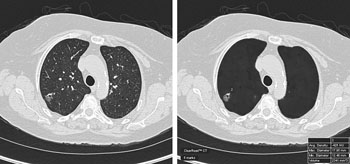CT Nodule Detection App Clears Lung Structure
By MedImaging International staff writers
Posted on 19 Oct 2016
A novel lung nodule detection application allows superior automatic nodule detection performance for all primary nodule types, including solid, sub-solid, and ground glass nodules.Posted on 19 Oct 2016
The Riverain Technologies (Miamisburg, OH, USA) ClearRead CT nodule detection application, powered by acquisition normalization technology, is designed to seamlessly processes computerized tomography (CT) scans from a wide range of manufacturers and acquisition protocols, suppresses lung vessel without the need for new hardware or customized tuning to specific protocols. The app is comprised of two powerful tools, ClearRead CT | Vessel Suppress, and ClearRead CT | Detect.

Image: The ClearRead CT suppresses lung structures to identify nodules (Photo courtesy of Riverain Technologies).
The ClearRead CT | Vessel Suppress tool was built using hundreds of normal scans spanning many different acquisition protocols, using thousands of simulated nodules to capture the large variety of different morphologies, texture, and attenuation characteristics of real nodules. The tool works by predicting the local lung air value, except where there is nodule tissue, which is left unaltered. Vessel suppression also suppresses the bronchial tree and pulmonary fissures, thus essentially suppressing all normal structures.
ClearRead CT | Detect is built on top of ClearRead CT | Vessel Suppress; using the vessel suppressed CT series, candidate nodules are detected using nothing more than simple thresholding and morphological post-processing. Through vessel suppression, nodules can thus be robustly and consistently detected, segmented, and characterized. Detect attempts to limit the number of false positives--such as residual vascular structure, bronchial wall, or scarring--but the radiologist must remain diligent, as some nodules may be inadvertently removed in the process.
Concurrent reading and deep learning enable the vessel suppression technology to assist both machine and humans in the detection and characterization of all primary nodule types, allowing for previously unattained detection performance. In a recent multi-reader, multi-case clinical trial, radiologists achieved a 29% reduction in missed actionable nodules, while reducing reading time by 26%. The ClearRead CT nodule detection application has been approved by the U.S. Food and Drug Administration (FDA).
“Achieving high reading efficiency while maintaining accuracy is increasingly important given the burden placed on today’s radiologists. With more patients and increased data volume due to thinner sections, ClearRead CT offers a critical advantage,” said Steve Worrell, CEO of Riverain. “The use of deep learning and other key technologies to suppress the vessels in CT scans proved to be essential in realizing a product capable of achieving the two competing objectives.”
Related Links:
Riverain Technologies













